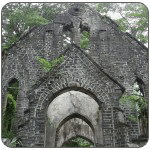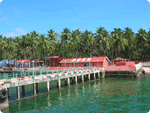Paris of the East
The ruins of Ross Island speak of better days and a long forgotten history
 The East India Company came to the Andaman Islands in 1788 to make it a penal settlement for Indian freedom fighters. Thus opened a new chapter in the darkest page of Indian history "Kalapani". Ross Island, situated 10 minutes (by boat) from Port Blair became the capital and seat of power.
Named after an the marine surveyor, Sir Daniel Ross, the Island enjoyed all modern facilities and architectural mastery. Later, when generators were installed, electricity was made available and at night Ross Island was like a bedecked ship and thus was named Paris of the East.
The East India Company came to the Andaman Islands in 1788 to make it a penal settlement for Indian freedom fighters. Thus opened a new chapter in the darkest page of Indian history "Kalapani". Ross Island, situated 10 minutes (by boat) from Port Blair became the capital and seat of power.
Named after an the marine surveyor, Sir Daniel Ross, the Island enjoyed all modern facilities and architectural mastery. Later, when generators were installed, electricity was made available and at night Ross Island was like a bedecked ship and thus was named Paris of the East.
 Important locations
The swimming pool was a popular place where the members of the exclusive settlement club met. The principal water source was rain.
The Subordinate Club was meant for non-commissioned and junior commissioned officers. The dance floor was made of teak and the entire window frame and its panes were made of stained glass from Italy.
The Government House - Chief Commissioner's Bungalow is located in the northern peak of Ross. It consisted of 12 rooms, seven to eight of which were bedrooms. The bungalow also included a tennis court, aviary and a palm house. It is said that the chief commissioner never closed the doors of the bungalow except for rain and other natural elements.
The Protestant church was built with stone, the window frames made of Burma teak and windows were etched Italian stained glass.
Important locations
The swimming pool was a popular place where the members of the exclusive settlement club met. The principal water source was rain.
The Subordinate Club was meant for non-commissioned and junior commissioned officers. The dance floor was made of teak and the entire window frame and its panes were made of stained glass from Italy.
The Government House - Chief Commissioner's Bungalow is located in the northern peak of Ross. It consisted of 12 rooms, seven to eight of which were bedrooms. The bungalow also included a tennis court, aviary and a palm house. It is said that the chief commissioner never closed the doors of the bungalow except for rain and other natural elements.
The Protestant church was built with stone, the window frames made of Burma teak and windows were etched Italian stained glass.
 The cemetery is the final resting place for many who died of water borne diseases and malaria. Most of the deceased were young. The youngest was Lawrence, born on September 16, 1863 who survived only for 22 hours.
Some of the other places of interest are the distilling plant, troop's barracks, bakery and hospital.
The penal settlement lasted until 1942, when the British left the islands and disbanded it. The Japanese also used Ross Island during World War II.
On April 18, 1979, Ross Island was handed over to the Indian Navy and on December 6, 1993, the Indian Navy set up "Smrithika" - the Ross memorial. A few buildings have been renovated but the rest are in ruins, engulfed in the roots of giant trees.
Now the Paris of the East is like a s haunted island, the ruins telling many a dark story.
The cemetery is the final resting place for many who died of water borne diseases and malaria. Most of the deceased were young. The youngest was Lawrence, born on September 16, 1863 who survived only for 22 hours.
Some of the other places of interest are the distilling plant, troop's barracks, bakery and hospital.
The penal settlement lasted until 1942, when the British left the islands and disbanded it. The Japanese also used Ross Island during World War II.
On April 18, 1979, Ross Island was handed over to the Indian Navy and on December 6, 1993, the Indian Navy set up "Smrithika" - the Ross memorial. A few buildings have been renovated but the rest are in ruins, engulfed in the roots of giant trees.
Now the Paris of the East is like a s haunted island, the ruins telling many a dark story.
Courtesy by Young World, The Hindu

